The Brahma chicken. All about the gentle giant.

I started breeding Brahma chickens in spring of 2003. The Brahma are a very friendly, docile breed. None of my roosters have ever been aggressive with me. The hens are reasonably good layers of large brown eggs.
They are available in both bantam and large fowl.
So far, the Brahma chicks have been very easy to hatch, brood, and raise. This breed does very well in cold and hot weather. At around 7 weeks of age you can start to guess the genders of the chicks. At around 12 or so weeks of age you should know for sure the sexes of your chicks. The hens usually start laying around 6 months of age. My hens usually lay every other day.
Table of Contents
Brahma are gentle giants with feathered legs and feet and profuse, fluffy feathering.
The birds used to breed the Brahma originally came from the East and these birds have been bred for meat production, though the hens lay relatively decently and are great setters and mothers. This fancy breed of chicken makes a great pet for its quiet and tame nature and tolerance to the cold.
Below: Brahma chickens are large, docile and pretty chickens.
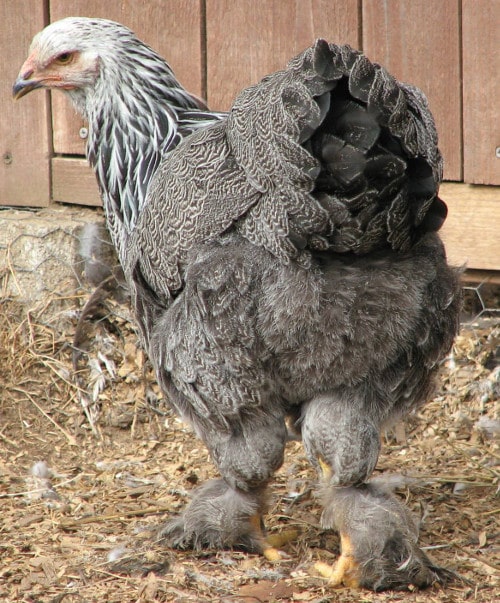
Although the name Brahma is taken from the river Brahmaputra in India, it is now generally agreed that they were created in America from large feather-legged birds imported from China in the 1840's known as Shanghais.
The theory set up by one writer, that 6 the first pair of Brahma were brought from Luckipoor up the Brahmaputra River, in a ship to New York, by a sailor ' whose name has never been given, is sheer romance and nonsense.
These were crossed with Malay-type birds from India, known as Grey Chittagongs, which introduced the pea comb and the beetle brow. Rivalry between breeders of various strains led to a wide variety of names and much confusion
A panel of judges meeting in Boston, MD, USA, in 1852 declared the official name to be Brahmapootras, later shortened to Brahma. After a consignment of nine birds was sent to Queen Victoria in 1852, the Brahma became one of the leading Asiatic breeds in this country. Great birds to keep, the gentle giants of the poultry world.
The Brahma breed overview:
Primary use: Dual purpose for both eggs and meat. Also a regular on the show bench for exhibition.
Size: The Brahma is a large tall breed of chicken.
Comb: Pea comb
Weight: Cockerel: 3.2-3.6Kg, Hen: 2.25-2.7Kg. Bantam Cockerel: 680-790g Bantam Hen: 570-680g
Origin: First bred in the US from imported oriental birds.
Eggs: 160-200 large light brown eggs per year.
Class: Rare breed. The Brahma is classes as Asiatic breed of chicken.
Temperament: Friendly, Easily handled, Calm,Bears confinement well, Docile.
Cold hardy: Good climate tolerance and handles all weather conditions.
Breed Colours / Varieties: Light, Buff, Dark, Gold, Black, White, Blue, Buff Colombian, and Blue Colombian. Only the Light, Dark and Buff are recognised by the APA.
Broodiness: Average to regular, better in their second year.
Availability: Difficult to find good ones.
Useful to Know: Sturdy slow growing chickens that forage well.
What do Brahma chickens look like?
The Brahma is a tall and well built chicken with feathery legs and this height of up to 32 inches makes it look much bigger than it actually is.
They have copious amount of large soft feathers which helps with the way they look.
Breed images: Day old lavender Brahma chicks.
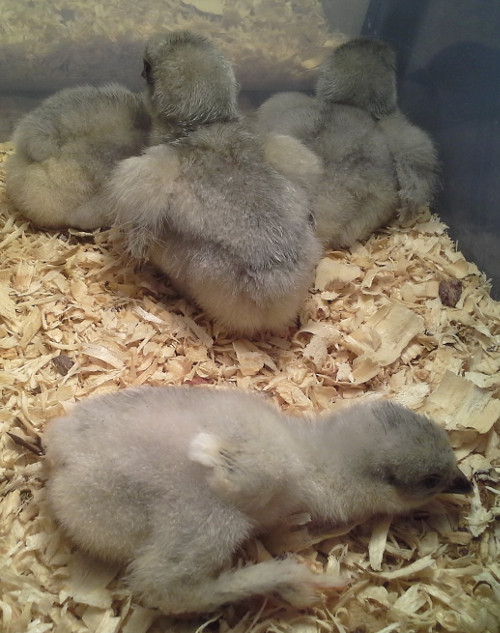
Below: A buff Brahma rooster.
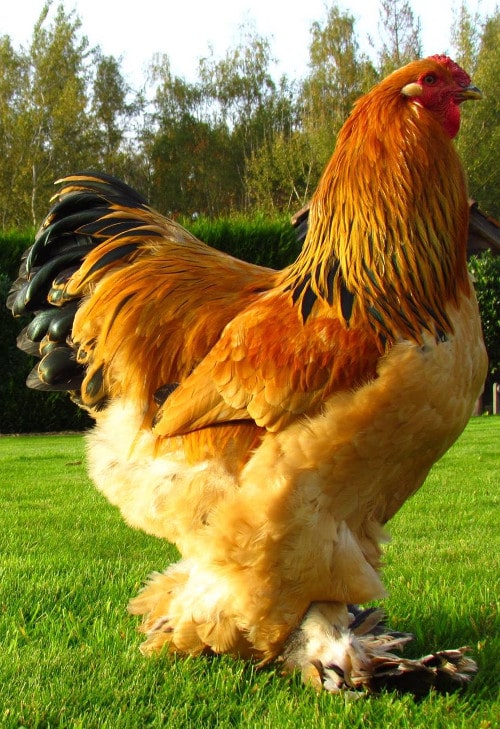
Below: The characteristic small or fine head of the Brahma hen.
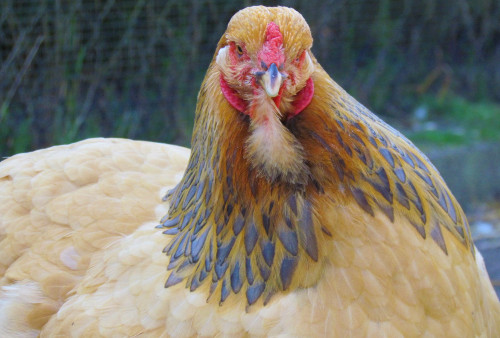
Brahma colours:
There are three recognised colours although many more are being bred around the world.
The light Brahma has a base colour of white, the Colombian feather pattern of black hackles edged in white and a black tail and the saddle-feathers of the cockerel are striped with black.
The dark Brahma shows the most differences between male and female: The hen has a dark Gray and black pencilled feathers with the same hackle as the light, whereas the cockerel has black and white hackles and saddle feathers, and a black base and tail. The wings are white-shouldered, and the primary feathers are edged with white.
The Buff Brahma has the same pattern of black as the light, but with a golden buff base colour instead of white.
Disqualifications: Round or crooked back, crooked beak, or any bodily deformity; knock-knees, or any large red or white splashes in the Dark breed; pinky legs in any type.
Where do Brahma chickens come from?
The history of the Brahma chicken starts when the ancestors of the first Brahma were brought to the United States in 1835 from China. The earliest male imports to the USA weighed around 14 pounds. They were used as a utility fowl for both their meat and eggs.
Today Brahma are mainly kept for eggs and ornamental purposes as they are slow growing.
Not much is known about the early history of the Brahma but they were established as a breed in America by 1847 and in 1856 a Mr Burnham presented a pen to Queen Victoria.
In his book " The China Fowl" from 1874 The author, George P Burnham writes on the origin of Brahma.
"NO subject has caused so much, so long, and such angry discussion in the poultry world as the origin of the Brahma fowl, though the variety was unquestionably first introduced into England as late as the year 1852, when two pens were shown at Birmingham by Mrs. Hosier Williams and Dr. Gwynne."
He goes on to write:
"There is no evidence to show that they came from India. The banks of the Brahmaputra have long been in the possession of the British, and no such fowls were ever seen in the locality. In fact, Brahma originated, not in India, but in America; and the two varieties of the breed now known as Dark and Light had unquestionably very distinct origins!'"
And:
"It appears then, both from the statements of private correspondents and from various papers of the period, that the first public exhibition of Light Brahma took place at the Fitzburg Poultry Show, on October 2nd, 3rd, and 4th, 1850. They were chickens, and were the property of Dr. J. C. Bennett, of Great Falls. This pen was considered magnificent in every way, and was the principal attraction of the show. "
The author also mentions he paid the sum of $100 dollars for the pair which was a considerable sum in those days.
"Now, it should be observed just here, that Dr. Bennett's Poultry Book, published by Phillips & Sampson of Boston in 1851, makes no mention whatever of the " Brahmaputra" or the " Brahma " fowl. He does mention the "Gray Chittagong," however; and the illustrations of this breed in his book are the very fowls he afterwards purchased of me; which he bred from, and the progeny of which he first called " Burampootras," and subsequently worked down into " Brahma : " while this further important fact must not be lost sight ot just here, also, that, notwithstanding Dr. Bennett published his excellent Poultry Book in 1850 and 1851, this name " Brahma " or " Brahma Poutra " does not appear in its pages at all, and no allusion whatever is made to this name in that work by Dr. Bennett, or to Mr. Cornish's or Chamberlin's existence.
How did the Brahma get it's name?
'Although the name Brahma is taken from the river Brahmaputra in India, it is now generally agreed that they were created in America from large feather-legged birds imported from China in the 1830's known as Shanghais.
The theory set up by one writer, was that the first 6 pairs of Brahma were brought from Luckipoor up the Brahmaputra River, in a ship to New York, by a sailor ' whose name has never been given. This story is sheer romance and nonsense.
Below: A Brahma in its show cage.

In his book " The China Fowl" from 1874 The author, George P Burnham writes on how the Brahma got it's name:
"The Doctor (Dr. Bennett) always gave me credit for what was then exactly true. We differed simply in our opinions as to what name this splendid variety should be called by. I adhered to " Gray Shanghai; " and he coined the title of " Burampootra," " Brahmaputra," and finally "Brahma," as it now stands in England and America.
Further evidence comes from a report by the committee after the Boston exhibition which includes the text:
" The largest, and unquestionably one of the finest varieties ever shown among us, was entered by the owner of this variety as the ' Chittagong.' Other coops, of the same stock, were labelled 'Gray Chittagong;' others of the same stock were called Bramah Pootras;' and others, Gray Shanghai.'
Below: The birds in question from the poultry show.

" Your Committee are divided in opinion as to what these birds ought rightfully to be called; but the majority of the Committee have no idea that "Bramah Pootra' is their correct title. . . . Several of the specimens are positively known to have come direct from Shanghai ; and none are known to have come originally from anywhere else. For the present, however, the Committee accept for them the title of 6 Gray Shanghai/ ' Chittagong,' or 6 Bramah Pootra,' as different breeders may elect, — admitting that they are a very superior bird, and believing . . . they will be found decidedly the most valuable among all the large Chinese breeds, of which they are clearly a good variety."
This is quoted accurately from the Report published in 1852, when several parties showed the Light-Gray stock, in competition, under the different names above indicated. But the Committee of Judges — who saw at a glance that all the birds were identical in colour, shape, and characteristics - deemed it but just to comment as they thus did upon this unwarrantable diversity of naming.
Sexing Brahma chicks:
The sex of Brahma chickens can in nine cases out of ten be easily distinguished at about a fortnight old. The wings of the little cockerels are narrow and pointed, while in the pullets they are broad and rounded at the end. The cockerels also show much dark colour in the wing feathers, while the pullets are nearly white in the light breed, and pencilled in the dark.
Later on, pencilling generally appears in the wings of the cockerels also ; but the difference is still easily seen by the pullets fledging down the breast and on the shoulders, long before the cockerels show a vestige of body-feathering anywhere. Not infrequently pullets may be seen almost fledged, while the cockerels are nearly bare, especially when the parents on both sides are young birds.
Breed FAQ's
How big is a Brahma chicken?
When it comes to size, the Brahma is one of the biggest chickens there is. They surpasses most other breeds, except the gigantic Cochin and the Jersey giant I have bred many cockerels which in their second year, as the Brahma continues to grow during the second season, reached thirteen to fourteen pounds.
Below: A reference from an old poultry book to the size of the Brahma.

How many eggs does a Brahma chicken lay?
Brahma chickens are relatively good layers of large light brown eggs and will produce between 150 and 200 eggs per year. The eggs are a good size and are generally between 55 and 60 grams.
Below: A selection of Brahma eggs.

How old are Brahma chickens when they start laying eggs?
The Brahma is not quick to point of lay as is usual with large heritage breeds of chicken. It may be 30 weeks before they begin to regularly produce good numbers of eggs and the first eggs may be disappointingly small for a few weeks.
It takes a correspondingly long time for a Brahma chicken to mature and they continue to grow and fill out in their second year.
Can you eat Brahma chicken?
Yes, the Brahma was originally used as a dual-purpose and meat chicken.
The quality of the meat is also good and I think the leg of a Brahma cockerel one of the best parts of the bird.
Birds can be used for meat any time from about 20 weeks up until 15 months old by which time they will yield a huge roasting bird with firm flesh.
It fell from favour as a meat bird because of the long time it takes to raise them to slaughter age.
Are Brahma chickens noisy?
Brahma are a quiet chicken. Mine make very little noise at all and even though they cockerel have quite a crow they never seem to use it.
Are Brahma chickens friendly or aggressive?
They are some of the most friendly and easy going chickens I have ever owned. They are no trouble, never end up escaping or getting into the trees and are generally well behaved around other birds.
Even when broody the Brahma hen is well natured and not aggressive like some and I have never had a bad tempered cockerel.
Are Brahma's broody?
The tendency to incubate varies greatly in different individuals. Even two sisters, hatched in the same brood, one of which only laid about twenty eggs before desiring to sit, and the other more than fifty. But in nearly all Brahma there is this peculiarity, which we do not think has been before noticed, that the hens in their second year lay very much longer than the pullets.
Another great advantage in this breed is, that if broods are not wanted, the tendency to incubation, unlike the Cochin, is very easily checked. If the bird be taken from the nest at once, and put in a box-coop, or under a basket-coop on hard ground, with plenty of water and food, two days will often effect the purpose, especially if two birds can be thus cooped together.
Do Brahma chickens need any special care?
Generally the Brahma is a sturdy bird that requires little extra care from its keepers.
As with all chickens that have feathery legs and feet there can be problems in wet and damp conditions like winter. It is supposed to be more prone to bumblefoot because of its size but that has not been my experience.
The constitution of the chicks, when bred from mature birds, is excellent and they are for the most part a sturdy breed that suffers little.
There have been some issues with leg weakness both bone problems and muscular weakness. Muscular debility we find generally in very heavy birds, and is shown by the unsteady, gait and the frequent squatting down plump on the ground.
They should be give plenty of space for activity from a very young age to make sure the muscles and bones grow good and strong.
Brahma need a lot of room and a coop with some height as well as space. They are big birds with a large wingspan and colliding with walls in a small coop is going to cause injuries.
How long do Brahma chickens live?
The Brahma can live for between 6 and 8 years much the same as other chickens. My oldest was 11 years old when he died. The hens maybe a little shorter as they have the stress of laying.
Where to get Brahma and how much to pay for them:
There are a few places you can look to try and get Brahma.
- Join the breed club and look for breeders.
- Try the Facebook groups.
- Visit poultry auctions.
- Buy hatching eggs on ebay.
You can expect to pay between $2 an $10 each for hatching eggs depending on the quality of the stock you are buying.
Day old Brahma chicks will set you back anything between $3 and $15 each.
Full Grown Brahma chickens at point of lay are Likely to be $35 to $8 each again depending on the quality and the type.
Some colours or types will be more expensive.
Brahma breed standards:
The back should be wide, and flat across, with scarcely any apparent length, the saddle appearing to rise almost from the base of the hackle. A round back is a great deformity, and a very narrow bird is not to be tolerated in a pen. The saddle cannot be too broad, and ought to rise well towards the tail
The breast ought to be deep, full, and broad, if rather projecting so much the better. The breast-bone or keel should be deep and well down between the thighs. The shoulders of the wings should not be too sharp and prominent.
Below: The ideal shape of the Brahma cockerel.
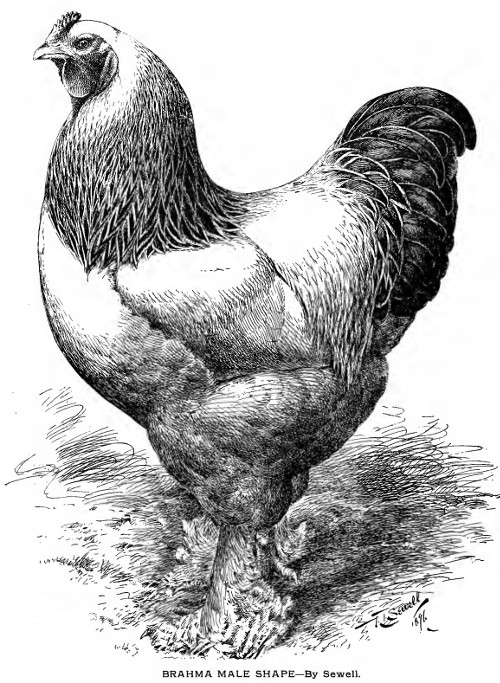
The wings should be of medium size, and well tucked up under the saddle feathers, their points pressing tightly into the fluff on the thighs. A slipped or disordered wing is a great blemish.
The thighs should be furnished with an ample supply of the plumage so well described as "fluff," but somewhat harder and more compact than in the Cochin. The lower feathers should in our opinion cover the hock joint, but curling well round it.
The shanks ought to be short and as well feathered as possible, so the bird be bred honestly without showing vulture hock. Both the outer and middle toes should be feathered ; but sometimes very heavily feathered birds have the middle toe bare
Below: The ideal shape for the Brahma hen.
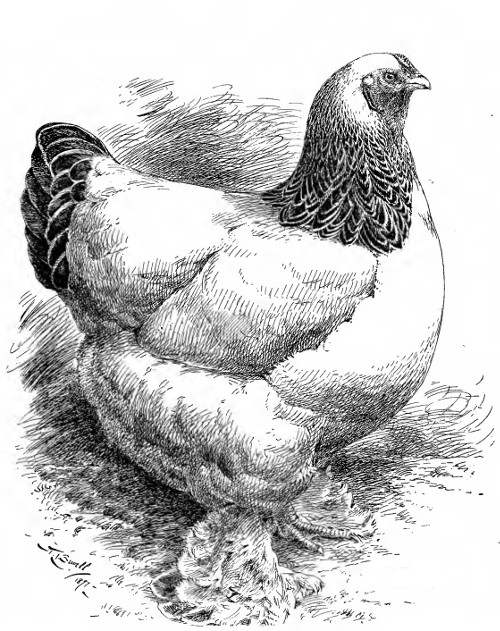
The shape and carriage of the hen should correspond with that of the cock, allowing for the difference of sex. Her head should in particular be as small as possible, this point being, of much greater moment in her case, with the same slight fullness over the eye, giving to the face an expression we can only describe as " arch," but at the same time peculiarly sweet and gentle.
In both sexes the shanks should stand as wide apart as possible, any approach to knock-knees being instantly disqualified ; and the feet should be rather large, with straight well-spread toes.
